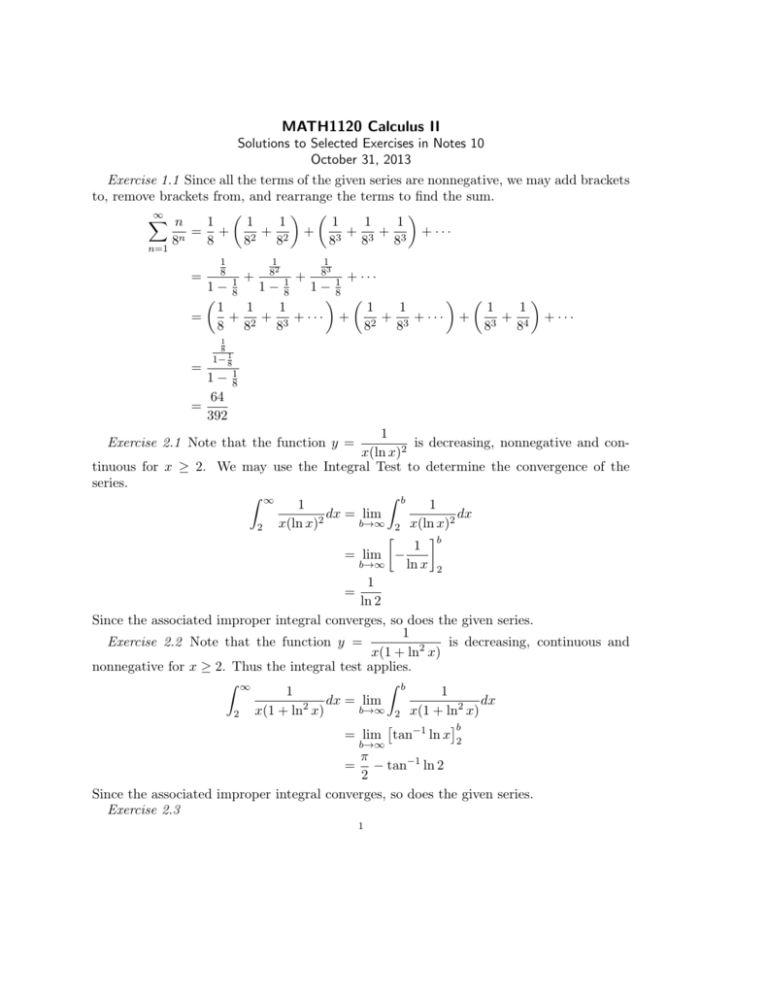MATH1120 Calculus II
advertisement

MATH1120 Calculus II Solutions to Selected Exercises in Notes 10 October 31, 2013 Exercise 1.1 Since all the terms of the given series are nonnegative, we may add brackets to, remove brackets from, and rearrange the terms to find the sum. ∞ X 1 1 1 1 1 n 1 = + + + + + ··· + 8n 8 82 82 83 83 83 n=1 1 8 1 82 1 83 + ··· 1 − 18 1 − 18 1 − 18 1 1 1 1 1 1 1 + ··· = + 2 + 3 + ··· + + + · · · + + 8 8 8 82 83 83 84 = + + 1 8 = 1− 81 1− 64 = 392 1 8 1 is decreasing, nonnegative and conx(ln x)2 tinuous for x ≥ 2. We may use the Integral Test to determine the convergence of the series. Z b Z ∞ 1 1 dx = lim dx 2 b→∞ 2 x(ln x)2 x(ln x) 2 1 b = lim − b→∞ ln x 2 1 = ln 2 Since the associated improper integral converges, so does the given series. 1 Exercise 2.2 Note that the function y = is decreasing, continuous and x(1 + ln2 x) nonnegative for x ≥ 2. Thus the integral test applies. Z ∞ Z b 1 1 dx = lim dx 2 b→∞ 2 x(1 + ln2 x) x(1 + ln x) 2 b = lim tan−1 ln x 2 Exercise 2.1 Note that the function y = b→∞ π − tan−1 ln 2 2 Since the associated improper integral converges, so does the given series. Exercise 2.3 = 1 2 (1) Note that for any positive number c, there exists a positive integer N such that such that for all n > N , ln n < nc 1 Take c = . Then 8 (ln n)2 n ∞ X 1 5 3 2 converges as p = 1 < n4 n 3 2 1 = 5 for all n > N n4 ∞ X 5 (ln n)2 > 1. By the Direct Comparison Test, 3 4 n2 n4 n=1 converges as well. ∞ X 1 1 1 < 2 for all n > 0 and converges because p = 2 > 1, (2) Since 2 n + 30 n n2 n=1 ∞ X 1 converges by the Direct Comparison Test. n2 + 30 n=1 n=1 Exercise 2.4 (1) By picking the dominant term of each factor of each term of the given series, we ∞ ∞ X X 1 n·n = to be the series with which we compare the given series. choose n2 · n n n=1 n=1 n(n+1) (n2 +1)(n−1) lim 1 n→∞ n n2 (n + 1) n→∞ (n2 + 1)(n − 1) = lim = lim n→∞ 1+ 1+ 1 n2 1 n 1− 1 n 1 2 >0 = Since ∞ X 1 diverges, so does the given series by the Limit Comparison Test. n n=1 3 (2) Note that lim ln 1 + 1 n2 n→∞ 1 n2 1 = lim n ln 1 + 2 n→∞ n 2 1 n = lim ln 1 + 2 n→∞ n 2! 1 n = ln lim 1 + 2 n→∞ n 2 = ln e =1 >0 (3) Note that ∞ X n=1 ∞ X 2 1 = . 1 + 2 + ··· + n n(n + 1) n=1 2 n(n+1) lim 1 n→∞ n2 2n2 n→∞ n(n + 1) 2 = lim n→∞ 1 + 1 n =2 >0 = lim ∞ X 1 converges, so does the original series by the Limit Comparison Test. Since n2 n=1 P 2 2 2 2 Observe that = − . The n-th partial sum sn of ∞ n=1 n(n+1) is n(n + 1) n n+1 2 . Thus 2− n+1 ∞ X 2 = lim sn n(n + 1) n→∞ n=1 = lim 2 − n→∞ 2 n+1 =2 ∞ X sin 1 1 1 > 0 for all n, and lim 1 n = 1 > 0. Since diverges, so n→∞ n n n n=1 does the given series by the Limit Comparison Test. (4) Note that sin 4 (5) By picking the dominant term of each factor of each term of the given series, we ∞ ∞ X X n 1 choose = to be the series with which we compare the given 3 2 n ln n n ln n n=2 n=1 series. n+1 (n3 +1) ln n lim 1 n→∞ n2 ln n (n + 1)n2 n→∞ n3 + 1 = lim 1 + n1 n→∞ 1 + 13 n =1 >0 = lim ∞ X ∞ X n+1 1 So both and have the same convergence property by 3 2 (n + 1) ln n n ln n n=2 n=1 the Limit Comparison Test. Note that 1 1 < 2 for all n > 1 2 n ln n n ∞ X 1 1 and converges, so does 2 by the Direct Comparison Test. Consequently 2 n n ln n n=1 the given series converges.






